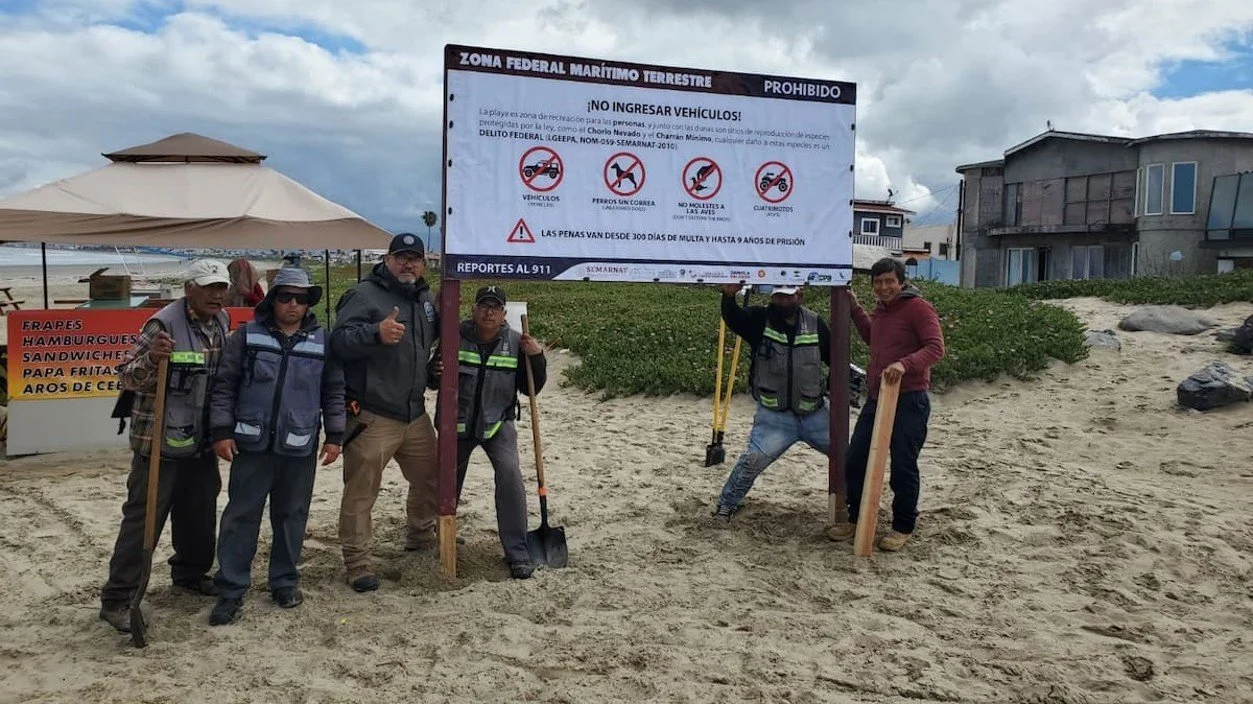Final Report of 2025 Western Snowy Plover Nesting Season in Punta Banda
-by John Kinabrew
The 2025 Western Snowy Plover nesting season on the beaches of Todos Santos Bay started with controversy.
In March, ATV rentals and other motorized vehicles began illegally driving on the beaches in Punta Banda at a sudden and unprecedented level. With such regular disturbance it would be impossible for snowy plovers to nest on the Punta Banda beach the way they had in previous years. One of the reasons snowy plovers are endangered is because they are so sensitive to disturbances during their April to August nesting season.
ATV tracks on the beach just before start of plover nesting season, in area where plovers nest
The snowy plover “nest” is only a shallow depression in the sand, hence the eggs are particularly vulnerable to traffic
With the 2025 nesting season about to begin, this emergency elicited a strong community and governmental response. At the urging of Punta Banda Conservation Alliance member organizations and others, the illegal vehicle threat was countered by a dramatic and sudden enforcement of existing laws. Signage was greatly increased on the affected beach. Local police gave offending parties warnings and/or tickets. And the illegal driving of vehicles on the beach did decrease greatly during and after Semana Santa. But how did this early drama affect nesting on the beach in 2025?
Signs were created and posted on multiple beaches in response to the outcries about the heavy ATV traffic. Although too small to see in this photo, the Punta Banda Conservation Alliance is included among the logos along the bottom of the sign acknowledging entities responsible for making these signs happen.
It is impossible to say for certain but at least on the most affected stretch of beach in front of the Punta Banda houses there were many fewer snowy plover nests in 2025 than there were in 2024.
Four nests were found in the stretch of beach from Fisher Camp north to the end of the houses and of those four, only two were successful in hatching chicks. The other two nests were abandoned before the eggs hatched, despite each nest being protected by a 1 x 1 x 1 meter wire cage and a temporary rope enclosure.
Despite these low nesting numbers for 2025, we are looking forward to the 2026 season and beyond, as there is much reason for hope. The city of Ensenada has declared the Western Snowy Plover a municipally protected bird and has declared June 12th henceforth Western Snowy Plover Day in the city of Ensenada.
Continued enforcement of the motorized vehicle ban on the beach can make a difference in the future if community members are vigilant and call 911 when they see such illegal activities.
Also, it is important to note that the four nests already mentioned were not the only snowy plover nests found on Todos Santos Bay beaches in 2025. A total of 17 nests were recorded. Nine nests were documented on Lengueta Arenosa between the end of the houses and the mouth of the Estero and another four nests were documented on the El Cipres beach north of the mouth of the Estero.
All but two of these other documented nests were successful. So the best total available for all the Todos Santos Bay beaches for 2025 is 17 snowy plover nests, with 13 successful hatches.
Continued community support and involvement is essential to the continued nesting success of these little birds raising their families on Ensenada beaches. Indeed, as an endangered shorebird numbering worldwide perhaps 2000 to 4000 individuals, these efforts are necessary for the very survival of their species. If you are interested in being part of the 2026 Todos Santos Bay Western Snowy Plover nest monitoring and protection team, contact John Kinabrew at johnkinabrew4@yahoo.com.



